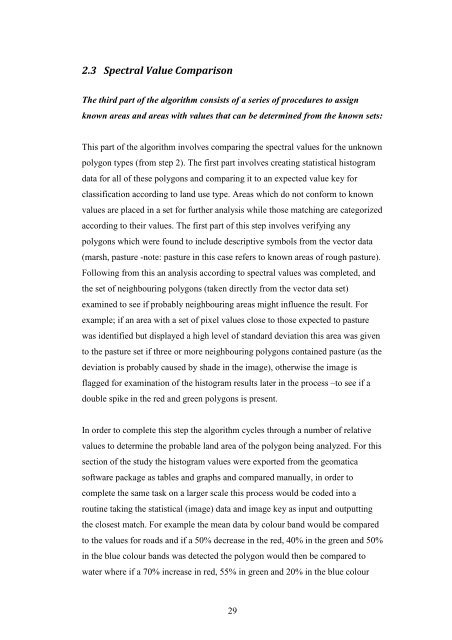Create successful ePaper yourself
Turn your PDF publications into a flip-book with our unique Google optimized e-Paper software.
2.3 Spectral Value Comparison<br />
The third part of the algorithm consists of a series of procedures to assign<br />
known areas and areas with values that can be determined from the known sets:<br />
This part of the algorithm involves comparing the spectral values for the unknown<br />
polygon types (from step 2). The first part involves creating statistical histogram<br />
data for all of these polygons and comparing it to an expected value key for<br />
classification according to land use type. Areas which do not conform to known<br />
values are placed in a set for further analysis while those matching are categorized<br />
according to their values. The first part of this step involves verifying any<br />
polygons which were found to include descriptive symbols from the vector data<br />
(marsh, pasture -note: pasture in this case refers to known areas of rough pasture).<br />
Following from this an analysis according to spectral values was completed, and<br />
the set of neighbouring polygons (taken directly from the vector data set)<br />
examined to see if probably neighbouring areas might influence the result. For<br />
example; if an area with a set of pixel values close to those expected to pasture<br />
was identified but displayed a high level of standard deviation this area was given<br />
to the pasture set if three or more neighbouring polygons contained pasture (as the<br />
deviation is probably caused by shade in the image), otherwise the image is<br />
flagged for examination of the histogram results later in the process –to see if a<br />
double spike in the red and green polygons is present.<br />
In order to complete this step the algorithm cycles through a number of relative<br />
values to determine the probable land area of the polygon being analyzed. For this<br />
section of the study the histogram values were exported from the geomatica<br />
software package as tables and graphs and compared manually, in order to<br />
complete the same task on a larger scale this process would be coded into a<br />
routine taking the statistical (image) data and image key as input and outputting<br />
the closest match. For example the mean data by colour band would be compared<br />
to the values for roads and if a 50% decrease in the red, 40% in the green and 50%<br />
in the blue colour bands was detected the polygon would then be compared to<br />
water where if a 70% increase in red, 55% in green and 20% in the blue colour<br />
29
















